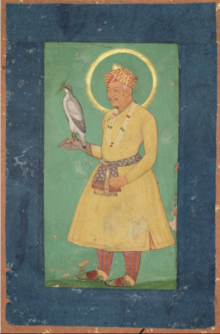| Lady Juliana | |
|---|---|
| Born | Juliana Mascarenhas |
| Occupation | Physician to Mughal emperor Akbar's royal harem |
| Years active | fl. mid 1500s |
| Known for | Built first church in Agra |
Lady Juliana (fl. mid 1500s) was a woman who lived at the court of Mughal emperor Akbar. She is said to have been the physician in charge of Akbar's royal harem, and to have married the legendary Bourbon prince Jean-Philippe de Bourbon-Navarre, and to have been the sister of one of Akbar's wives. She is credited with building the first church in Agra (now in India).
Origins

Lady Juliana was the sister of Akbar's Christian wife and was the physician in charge of the royal harem. At some point these sisters were brought to Agra.
One account is that Juliana and her sister were the daughters of Abdul Hai, Akbar's Chief Justice and that they were from Cilicia in Western Armenia.
Rev. Thomas Smith, an historian, scholar and journalist who was born into an Indo-Armenian family in Agra reports Lady Juliana as Armenian and given to Jean-Phillipe by Akbar.
In Prince Michael of Greece's research on the descendants of Jean-Phillipe de Bourbon, he feels "certain that he was the son of Charles III, the Constable of France, the richest and most famous and powerful member of the family". In Prince Michael's book Le Rajah de Bourbon, Jean-Phillipe married the Portuguese sister of the Christian wife of Akbar, was also given a large amount of land and became a Rajah (king) in India. He also explains how Jean-Phillipe was the first Bourbon French king, Henry IV's nephew and how sometime before 1560, Jean-Phillipe embarked on a worldwide adventure before landing at the gates of Akbar's empire. His subsequent marriage to Lady Juliana after she tended to him during a severe illness and was then gifted to him by Akbar, produced a long line of Bourbons in Bhopal, India.
Others too, have claimed her as Portuguese but research published by Zaman in 2012 has disputed Portuguese scholar, J. A. Ismael Gracias's belief that Akbar's wife or her sister were Portuguese. Many other ladies were also named Juliana. One Portuguese Lady Juliana Dias da Costa came later into Mughal history and her story may be contributory to the confusion with Lady Juliana Mascarenhas. Gracias describes Akbar's wife Maryam Makani being Maria Mascarenas and her sister being Juliana. This too is false according to Zaman, who argues that Maryam is the name given to Akbar's mother, Hamida Banu Begum.
Frederick Fanthome in Reminiscences of Agra (1895) expresses his conviction that Akbar had a Christian wife named Mary whose influence on Akbar had been underestimated by other historians. He recounts the story of Jean-Phillipe and similarly states his conviction of Akbar's leanings toward Christianity.
Untangling the Julias for Gracias and Fanthome was not so vital if understood in the context of their Christian faith and combined bloodlines and associations with the Mughals being the significant theme. In addition, it was also not irrational to understand why the Greek Prince would have an interest too, as in the 2007 article in The Guardian entitled “Found in India: The Last King of France”. In conclusion, Zaman understands previous accounts being part fact and part fiction at a time when Christian influences via European women appeared attractive, particularly in the final days of the Mughal Empire.
Life in India
Akbar arranged Juliana's marriage to Prince Jean-Phillipe de Bourbon of France in 1560 and paid for the construction of the church they built in 1562.
Death
According to the Agra Mission archives, she was buried with her husband in the church they established in 1562, although their remains were never found. Mughal Emperor Shah Jahan had the church demolished in 1636. The Native chapel was rebuilt over the site and in the compound of St Peter's Roman Catholic Cathedral.
Descendants of Lady Juliana and Jean-Philippe with the name "Bourbon" continue to reside in Bhopal.
References
- "The India-Armenia connection - The Statesman". The Statesman. 26 September 2015. Retrieved 22 October 2018.
- ^ Seth, Mesrovb Jacob (1983). Armenians in India, from the Earliest Times to the Present Day: A Work of Original Research. Asian Educational Services. pp. 92–93. ISBN 81-206-0812-7.
- The Illustrated Weekly of India. Published for the proprietors, Bennett, Coleman & Company, Limited, at the Times of India Press. January 1972.
- Study, Centre for Research in Rural and Industrial Development Centre for Caucasian (2008). India-Eurasia, the way ahead: with special focus on Caucasus. Centre for Research in Rural and Industrial Development. ISBN 9788185835532.
- Agra: Rambles and Recollections of Thomas Smith.
- Smith, Thomas; Kat julianahuria, Shailaja (2007). Agra: rambles and recollections of Thomas Smith. Chronicles Books. ISBN 9788180280290.
- ^ Prince Michael of Greece (29 March 2017). "The Emperor Akbar's Wives". www.princemichaelschronicles.com.
- ^ Chrisafis, Angelique (3 March 2007). "Found in India: the last king of France". the Guardian. Retrieved 26 October 2018.
- Gréce, Michel de (2010). The Raja of Bourbon. Roli Books Private Limited. ISBN 978-93-5194-018-0.
- Fernando, Leonard; Gispert-Sauch, G. (2004). Christianity in India: Two Thousand Years of Faith. Penguin Books India. p. 142. ISBN 9780670057696.
- ^ Zaman, Taymiya R. (2012). "Visions of Juliana: A Portuguese Woman at the Court of the Mughals". Journal of World History. 23 (4): 761–791. doi:10.1353/jwh.2012.0136. S2CID 145722574.
- "The Armenians of India". AGBU | Armenian non-profit organization. Archived from the original on 28 February 2020. Retrieved 22 October 2018.
- "Lost in France, found in India". www.telegraphindia.com. Retrieved 24 October 2018.
Further reading
- Maclagan Jesuits And The Great Mogul, by Edward Mclaga, Burns Oates & Washbourne Ltd (1932), London.
- The Raja of Bourbon, by Michel de Gréce, Roli Books Private Limited (2010), ISBN 978-93-5194-018-0
- Armenians in India From The Earliest Times to the Present Day, by Mesrovb Jacob Seth, self-published (1937)
- Reminiscences of Agra, by Frederic Fanthome, Thacker Spink & Co. (1895).